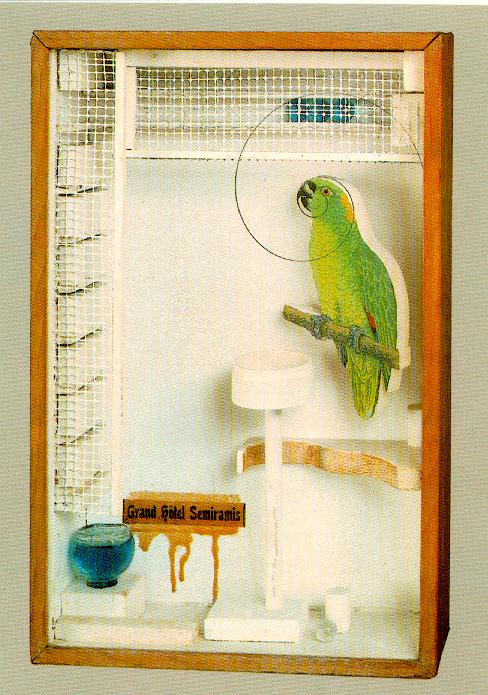 |
| Margaret Wharton Singles Game chair parts, tennis racket, golf clubs, golf tees 51 x 19 inches, 2011 |
found object artists
Margaret Wharton | Wharton's work focuses on the manipulation of objects such as chairs or books and their subsequent transformation into witty and critical works of art. Recent sculptures configured from chairs have an anthropomorphic quality. While objects/figures are suggested in the final works of art, the original object from which the piece was created is always apparent in an often ironic way. Precise craftsmanship and attention to detail continues to be integral to her artistic process. -JeanAlbanoGallery.com
 |
| Joseph Cornell Grand Hotel Semiramis 1950, Construction 18 x 11 7/8 x 4 in |
Joseph Cornell | It is speculated that Cornell first made his toy-like artworks to amuse his brother who was confined to a wheelchair and cared for by Cornell. He filled them with all sorts of ephemera, of which he was an avid collector. Cornell was known to haunt old book and print shops and junk stores during his daily trips to Manhattan, and he had extensive collections of old photographs, recordings, movies, opera librettos, souvenirs, and other memorabilia. He was enamoured of all forms of theater and was well read in literature and poetry.
A very private man, it is thought that he first began making boxes in which he collaged images and objects from his various collections in the early 1930s. The boxes, often containing words, were each based on themes developed by the relationships between collage elements. These connections were sometimes direct but more often allusive, giving the boxes a poetic quality. Cornell did many boxes that were homages to ballerinas, opera singers, and film stars he revered and sometimes corresponded with. The boxes were nostalgic worlds filled with people and places that Cornell admired from a distance. One such box entitled A Pantry Ballet for Jacques Offenbach contains a ballet corps of red plastic fish set against a background of shelf-paper which turns the box into a stage with paper doily curtains and menacing stagesets of toy silverware. The scale and nature of Cornell's boxes did not change much, but in the 1950s he began to make two-dimensional collages without the framework of the boxcontainer. -Encyclopedia.com
No comments:
Post a Comment